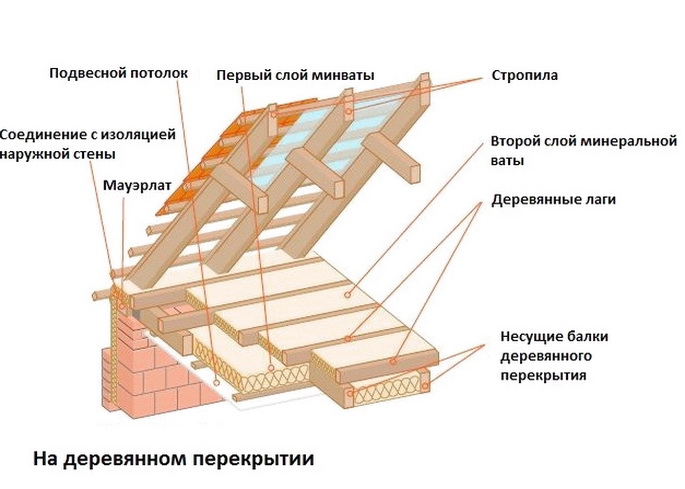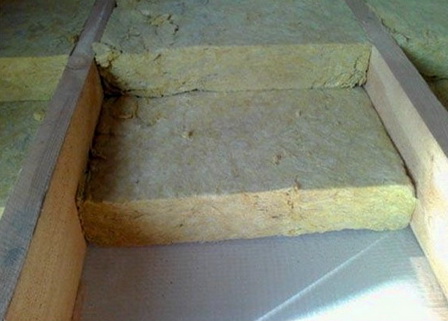Often you have to decide how to insulate wooden floors, because they are found in almost all private houses. Lightweight wooden beams (logs) do not require increased wall and foundation strength, they are not expensive, they are simply installed.
Beams are sheathed from above and (or) from below, often with boards, forming the floor and ceiling. The principles of insulation of all wooden floors are similar to each other, let's take a closer look at these technologies.
Choose insulation for a wooden floor
For a tree to serve for a long time, it must breathe, i.e. do not come into contact with materials that restrict air movement. Or at least a large surface area of the tree should not be insulated.Otherwise, wooden parts can quickly rust, rot due to a violation of steam exchange. For this reason, mineral wool or other vapor-transparent materials are mainly chosen for insulating wooden floors.
It is also important to consider fire safety when choosing a heater. A wooden floor cannot be considered an obstacle to fire, it does not fully isolate what is behind it from the living space. Therefore, it is not recommended to use materials hazardous by fire standards on wooden floors.
Again, the choice falls on non-combustible materials - mineral wool, expanded clay, vermiculite.
Styrofoam produces poison when melted or burned. Indoors, they should be located behind a plaster with a thickness of 3 cm or more, which resists flame for at least 30 minutes. And also should not come into contact with hot pipes, electrical wiring.
Insulation thickness
When choosing the thickness of insulation for the overlap, it is best to use the recommendations of SNiP. Then the insulation will be economically feasible. It is simply not profitable to apply a thin layer of insulation.Based on the recommended heat transfer resistance of the floor, it is not difficult to calculate the approximate thickness of the insulation (the heat transfer resistance is divided by the thermal conductivity of the material). In this case, the resistance to heat transfer of the floor itself is ignored as insignificant.
So, for the Moscow region, to insulate the attic floors of houses, at least 20 cm of mineral wool thickness will be required. And for floor insulation - at least 16 cm of mineral wool.

Floor structure
Consider an attic floor. Usually, the insulation is placed between the logs. But often their height is not sufficient, so you have to build a counter batten on top of the lag, and on top of it there is already some kind of flooring.The insulation must be isolated from the steam leaving the building, since the increased humidity of the insulation will lead to condensation of water. Therefore, you need to lower the humidity and get out of the dew point in the insulation. The vapor barrier is laid between the logs, always in a continuous layer, with overlapping parts and gluing the seams, with a twist on the sidewalls of the log at least 5 cm. 
The insulation is laid without gaps in the fold, a crate is made if necessary. (More often - 15 cm of logs plus 10 cm of lathing, of which 20 - 22 cm for insulation in two layers and 3 - 5 cm ventilation gap.)
The mineral wool must be covered with a diffusion membrane so that the fibers do not scatter, and also so that wind pressure does not affect. The membrane is attached to the sidewalls with a stapler as well as a vapor barrier. A layer of expanded clay must be covered on top with parchment, sand, etc. but this time to prevent convection currents inside the insulation.
When laying vapor barrier, membranes, insulation, the greatest attention should be paid to eliminating all kinds of cracks, gaps, and discontinuities. Cold bridges significantly reduce the effect of insulation.
Sound insulation, what is its feature
Interfloor wooden floors, as a rule, do not need insulation, unless a temperature difference between floors is provided. But soundproofing floors is often extremely important.For sound insulation, mineral wool is used as a good sound absorber. But the design should be different. Wooden logs are a conductor of impact sound, redirecting it to the walls, so they must be insulated.
A rough floor is made along the logs. Rigid mineral wool slabs with a density of 60 kg / m2 and a thickness of 40 mm are laid on it. A floating (not in contact with the walls) dry floor screed is made on top, usually from gypsum fiber board. The result is a soundproofing cake - an absorber between two reflectors.
A feature of the construction of a wooden floor is to prevent hazardous mineral wool fibers from scattering around the dwelling during the entire period of operation. The space where it is located is necessarily sealed, including with membranes.

Features of thermal insulation of wooden floors
The floors on the logs are insulated according to the same principle as the attic wooden floors - the insulation is located between the logs on wooden shields that are fixed from below. The only question is in the ventilation of the insulation layer.If the subfloor is well ventilated, i.e. it will freeze and the humidity does not rise there, (or for houses on piles with a grillage and an open underground), then the vapor barrier must naturally be laid from the side of the room.
And the diffusion membrane on the bottom of the lattice fence on the ventilation side. The thickness of the insulation in this case should be the same as for the attic. 
By the way, the bottom ventilation of the insulation in the underground is preferable if mineral wool is used. It is known to contain formaldehyde binders, and therefore it is not the best design option to ventilate it indoors (from above in the underground).
For insulation of the underground with overhead ventilation and vapor barrier from the ground, it is better to use more environmentally friendly insulation. As a last resort, all the same foam, shielding it with a metal mesh from the bottom of the mice.
Thermal insulation of wooden floors does not contain any difficulties, since it is not necessary to fasten the insulation. But it is imperative to provide vapor barrier and ventilation of vapor-transparent heaters and prevent water condensation in them.



